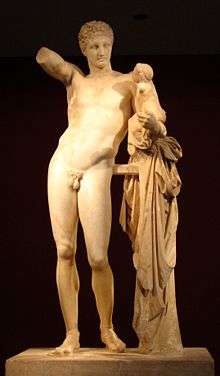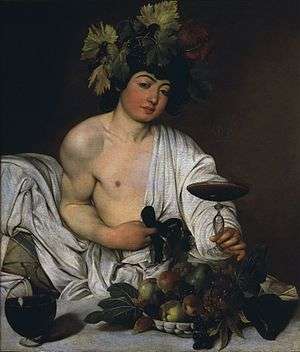Dionysus
| Dionysus | |
|---|---|
| God of the vine, grape-harvest, wine-making, wine, fertility, ritual madness, religious ecstasy, theatre | |
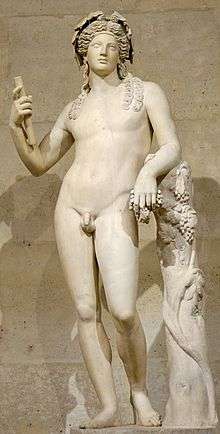 2nd-century Roman statue of Dionysus, after a Hellenistic model (ex-coll. Cardinal Richelieu, Louvre)[1] | |
| Abode | Mount Olympus |
| Symbol | Thyrsus, grapevine, leopard skin, panther, tiger, cheetah |
| Personal information | |
| Consort | Ariadne |
| Children | Priapus, Hymen, Thoas, Staphylus, Oenopion, Comus, Phthonus, the Graces, Deianira |
| Parents |
Zeus and Semele Zeus and Persephone (Orphic) |
| Siblings | Aeacus, Angelos, Aphrodite, Apollo, Ares, Artemis, Athena, Eileithyia, Enyo, Eris, Ersa, Hebe, Helen of Troy, Hephaestus, Heracles, Hermes, Minos, Pandia, Persephone, Perseus, Rhadamanthus, the Graces, the Horae, the Litae, the Muses, the Moirai |
| Roman equivalent | Bacchus, Liber |
| Etruscan equivalent | Fufluns |
| Greek mythology |
|---|
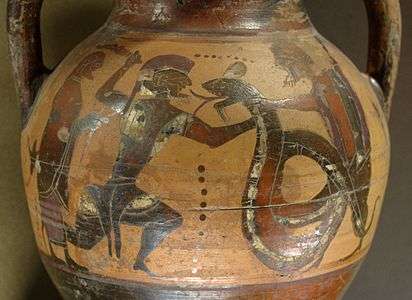 |
| Deities |
|
|
| Heroes and heroism |
|
| Related |
|
|
Dionysus (/daɪ.əˈnaɪsəs/; Greek: Διόνυσος Dionysos) is the god of the grape-harvest, winemaking and wine, of fertility, ritual madness, religious ecstasy and theatre in ancient Greek religion and myth.[2][3] Wine played an important role in Greek culture, and the cult of Dionysus was the main religious focus for its unrestrained consumption.[4] His worship became firmly established in the seventh century BC.[5] He may have been worshipped as early as c. 1500–1100 BC by Mycenaean Greeks;[6][7] traces of Dionysian-type cult have also been found in ancient Minoan Crete.[8] His origins are uncertain, and his cults took many forms; some are described by ancient sources as Thracian, others as Greek.[9][10][11] In some cults, he arrives from the east, as an Asiatic foreigner; in others, from Ethiopia in the South. He is a god of epiphany, "the god that comes", and his "foreignness" as an arriving outsider-god may be inherent and essential to his cults. He is a major, popular figure of Greek mythology and religion, becoming increasingly important over time, and included in some lists of the twelve Olympians, as the last of their number, and the only god born from a mortal mother.[12] His festivals were the driving force behind the development of Greek theatre.[13]
The earliest cult images of Dionysus show a mature male, bearded and robed. He holds a fennel staff, tipped with a pine-cone and known as a thyrsus. Later images show him as a beardless, sensuous, naked or half-naked androgynous youth: the literature describes him as womanly or "man-womanish".[14] In its fully developed form, his central cult imagery shows his triumphant, disorderly arrival or return, as if from some place beyond the borders of the known and civilized. His procession (thiasus) is made up of wild female followers (maenads) and bearded satyrs with erect penises; some are armed with the thyrsus, some dance or play music. The god himself is drawn in a chariot, usually by exotic beasts such as lions or tigers, and is sometimes attended by a bearded, drunken Silenus. This procession is presumed to be the cult model for the followers of his Dionysian Mysteries. Dionysus is represented by city religions as the protector of those who do not belong to conventional society and he thus symbolizes the chaotic, dangerous and unexpected, everything which escapes human reason and which can only be attributed to the unforeseeable action of the gods.[15]
He is also known as Bacchus (/ˈbækəs/ or /ˈbɑːkəs/; Greek: Βάκχος, Bakkhos), the name adopted by the Romans[16] and the frenzy he induces is bakkheia. His thyrsus, sometimes wound with ivy and dripping with honey, is both a beneficent wand and a weapon used to destroy those who oppose his cult and the freedoms he represents. As Eleutherios ("the liberator"), his wine, music and ecstatic dance free his followers from self-conscious fear and care, and subvert the oppressive restraints of the powerful. Those who partake of his mysteries are possessed and empowered by the god himself.[17]
The cult of Dionysus is also a "cult of the souls"; his maenads feed the dead through blood-offerings, and he acts as a divine communicant between the living and the dead.[18] He is sometimes categorised as a dying-and-rising god.[13]
In Greek mythology, he is presented as a son of Zeus and the mortal Semele, thus semi-divine or heroic: and as son of Zeus and Persephone or Demeter, thus both fully divine, part-chthonic and possibly identical with Iacchus of the Eleusinian Mysteries. Some scholars believe that Dionysus is a syncretism of a local Greek nature deity and a more powerful god from Thrace or Phrygia such as Sabazios or Zalmoxis.
Etymology
The dio- element has been associated since antiquity with Zeus (genitive Dios). The earliest attested form of the name is Mycenaean Greek 𐀇𐀺𐀝𐀰, di-wo-nu-so, written in Linear B syllabic script, presumably for /Diwo(h)nūsoio/. This is attested on two tablets that had been found at Mycenaean Pylos and dated to the 12th or 13th century BC, but at the time, there could be no certainty on whether this was indeed a theonym.[19][20] But the 1989–90 Greek-Swedish Excavations at Kastelli Hill, Chania, unearthed, inter alia, four artefacts bearing Linear B inscriptions; among them, the inscription on item KH Gq 5 is thought to confirm Dionysus's early worship.[7]
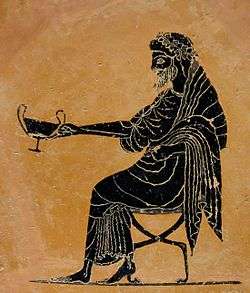
Later variants include Dionūsos and Diōnūsos in Boeotia; Dien(n)ūsos in Thessaly; Deonūsos and Deunūsos in Ionia; and Dinnūsos in Aeolia, besides other variants. A Dio- prefix is found in other names, such as that of the Dioscures, and may derive from Dios, the genitive of the name of Zeus.[21] The second element -nūsos is associated with Mount Nysa, the birthplace of the god in Greek mythology, where he was nursed by nymphs (the Nysiads),[22] but according to Pherecydes of Syros, nũsa was an archaic word for "tree".[23]
Nonnus, in his Dionysiaca, writes that the name Dionysus means "Zeus-limp" and that Hermes named the new born Dionysus this, "because Zeus while he carried his burden lifted one foot with a limp from the weight of his thigh, and nysos in Syracusan language means limping".[24] In his note to these lines, W. H. D. Rouse writes "It need hardly be said that these etymologies are wrong".[24] The Suda, a Byzantine encyclopedia based on classical sources, states that Dionysus was so named "from accomplishing [διανύειν ] for each of those who live the wild life. Or from providing [διανοεῖν ] everything for those who live the wild life."[25]
R. S. P. Beekes has suggested a Pre-Greek origin of the name.[26]
The cult of Dionysus was closely associated with trees, specifically the fig tree, and some of his bynames exhibit this, such as Endendros "he in the tree" or Dendritēs, "he of the tree". Peters suggests the original meaning as "he who runs among the trees", or that of a "runner in the woods". Janda (2010) accepts the etymology but proposes the more cosmological interpretation of "he who impels the (world-)tree". This interpretation explains how Nysa could have been re-interpreted from a meaning of "tree" to the name of a mountain: the axis mundi of Indo-European mythology is represented both as a world-tree and as a world-mountain.[27]
Epithets


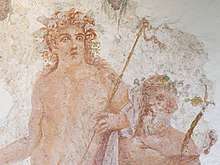
Dionysus was variably known with the following epithets:
Acratophorus, ("giver of unmixed wine"), at Phigaleia in Arcadia.[28]
Adoneus, a rare archaism in Roman literature, a Latinised form of Adonis, used as epithet for Bacchus.[30]
Aegobolus ("goat killer") at Potniae, in Boeotia.[31]
Aesymnetes ("ruler" or "lord") at Aroë and Patrae in Achaea.
Agrios ("wild"), in Macedonia.
Bassareus, a Thracian name for Dionysus, which derives from bassaris or "fox-skin", which item was worn by his cultists in their mysteries.[32]
Briseus ("he who prevails") in Smyrna.[33][34]
Bromios ("Roaring" as of the wind, primarily relating to the central death/resurrection element of the myth,[35] but also the god's transformations into lion and bull,[36] and the boisterousness of those who drink alcohol. Also cognate with the "roar of thunder", which refers to Dionysus' father, Zeus "the thunderer".[37])
Choiropsalas χοιροψάλας ("pig-plucker": Greek χοῖρος = "pig," also used as a slang term for the female genitalia). A reference to Dionysus's role as a fertility deity.[38][39]
Chthonios ("the subterranean")[40]
Dendrites ("he of the trees"), as a fertility god.
Dithyrambos, used at his festivals, referring to his premature birth.
Eleutherios ("the liberator"), an epithet shared with Eros.
Endendros ("he in the tree").[41]
Enorches ("with balls,"[42] with reference to his fertility, or "in the testicles" in reference to Zeus' sewing the baby Dionysus "into his thigh", understood to mean his testicles).[43] used in Samos and Lesbos.
Erikryptos ("completely hidden"), in Macedonia.
Euius (Euios), in Euripides' play, The Bacchae.
Iacchus, a possible epithet of Dionysus, associated with the Eleusinian Mysteries. In Eleusis, he is known as a son of Zeus and Demeter. The name "Iacchus" may come from the Ιακχος (Iakchos), a hymn sung in honor of Dionysus.
Liknites ("he of the winnowing fan"), as a fertility god connected with mystery religions. A winnowing fan was used to separate the chaff from the grain.
Lyaeus, or Lyaios (Λυαῖος, "deliverer", literally "loosener"), one who releases from care and anxiety.[44]
Melanaigis ("of the black goatskin") at the Apaturia festival.
Morychus (Μόρυχος, "smeared") in Sicily, because his icon was smeared with wine lees at the vintage.[45][46]
Oeneus, as god of the wine press.
Pseudanor (literally "false man", referring to his feminine qualities), in Macedonia.
In the Greek pantheon, Dionysus (along with Zeus) absorbs the role of Sabazios, a Thracian/Phrygian deity. In the Roman pantheon, Sabazius became an alternative name for Bacchus.[47]
Mythology
Birth, infant death and rebirth
Dionysus's mother was a mortal woman, Semele, the daughter of king Cadmus of Thebes, and his father was Zeus, the king of the gods. Zeus's wife, Hera, discovered the affair while Semele was pregnant. Appearing as an old crone (in other stories a nurse), Hera befriended Semele, who confided in her that Zeus was the actual father of the baby in her womb. Hera pretended not to believe her, and planted seeds of doubt in Semele's mind. Curious, Semele demanded of Zeus that he reveal himself in all his glory as proof of his godhood.

Though Zeus begged her not to ask this, she persisted and he agreed. Therefore, he came to her wreathed in bolts of lightning; mortals, however, could not look upon an undisguised god without dying, and she perished in the ensuing blaze. Zeus rescued the unborn Dionysus by sewing him into his thigh. A few months later, Dionysus was born on Mount Pramnos in the island of Ikaria, where Zeus went to release the now-fully-grown baby from his thigh. In this version, Dionysus is borne by two "mothers" (Semele and Zeus) before his birth, hence the epithet dimētōr (of two mothers) associated with his being "twice-born".
In the Cretan version of the same story, which Diodorus Siculus follows,[49] Dionysus was the son of Zeus and Persephone, the queen of the Greek underworld, while another of Diodorus' sources identified the mother as Demeter.[50] A jealous Hera again attempted to kill the child, this time by sending Titans to rip Dionysus to pieces after luring the baby with toys. It is said that he was mocked by the Titans who gave him a thyrsus (a fennel stalk) in place of his rightful sceptre.[51] Zeus turned the Titans into dust with his thunderbolts, but only after the Titans ate everything but the heart, which was saved, variously, by Athena, Rhea, or Demeter. Zeus used the heart to recreate him in his thigh, hence he was again "the twice-born".
Other versions claim that Zeus recreated him in Semele's womb or that he impregnated Semele by giving her the heart to eat.
His rebirth is the primary reason for the worship of Dionysus in several mystery religions. Variants of the narrative are found in Callimachus and Nonnus, who refer to this Dionysus with the title Zagreus, and also in several fragmentary poems attributed to Orpheus.
The myth of the dismemberment of Dionysus by the Titans, is alluded to by Plato in his Phaedo (69d) in which Socrates claims that the initiations of the Dionysian Mysteries are similar to those of the philosophic path. Late Neo-Platonists such as Damascius explore the implications of this at length.[52]
Infancy at Mount Nysa
According to the myth, Zeus gave the infant Dionysus to the care of Hermes. One version of the story is that Hermes took the boy to King Athamas and his wife Ino, Dionysus' aunt. Hermes bade the couple to raise the boy as a girl, to hide him from Hera's wrath.[53] Another version is that Dionysus was taken to the rain-nymphs of Nysa, who nourished his infancy and childhood, and for their care Zeus rewarded them by placing them as the Hyades among the stars (see Hyades star cluster). Other versions have Zeus giving him to Rhea, or to Persephone to raise in the Underworld, away from Hera. Alternatively, he was raised by Maro. In yet another version of the myth, he is raised by his cousin Macris on the island of Euboea.[54]
Dionysus in Greek mythology is a god of foreign origin, and while Mount Nysa is a mythological location, it is invariably set far away to the east or to the south. The Homeric Hymn 1 to Dionysus places it "far from Phoenicia, near to the Egyptian stream". Others placed it in Anatolia, or in Libya ("away in the west beside a great ocean"), in Ethiopia (Herodotus), or Arabia (Diodorus Siculus).
According to Herodotus:
As it is, the Greek story has it that no sooner was Dionysus born than Zeus sewed him up in his thigh and carried him away to Nysa in Ethiopia beyond Egypt; and as for Pan, the Greeks do not know what became of him after his birth. It is therefore plain to me that the Greeks learned the names of these two gods later than the names of all the others, and trace the birth of both to the time when they gained the knowledge.
— Herodotus, Histories 2.146
The Bibliotheca seems to be following Pherecydes, who relates how the infant Dionysus, god of the grapevine, was nursed by the rain-nymphs, the Hyades at Nysa.
Childhood
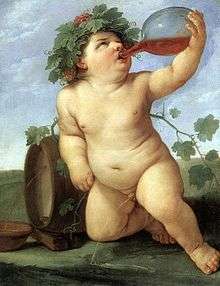
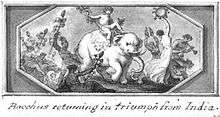
When Dionysus grew up, he discovered the culture of the vine and the mode of extracting its precious juice, being the first to do so;[55] but Hera struck him with madness, and drove him forth a wanderer through various parts of the earth. In Phrygia the goddess Cybele, better known to the Greeks as Rhea, cured him and taught him her religious rites, and he set out on a progress through Asia teaching the people the cultivation of the vine. The most famous part of his wanderings is his expedition to India, which is said to have lasted several years. According to a legend, when Alexander the Great reached a city called Nysa near the Indus river, the locals said that their city was founded by Dionysus in the distant past and their city was dedicated to the god Dionysus.[56] These travels took something of the form of military conquests; according to Diodorus Siculus he conquered the whole world except for Britain and Ethiopia.[57] Returning in triumph (he was considered the founder of the triumphal procession) he undertook to introduce his worship into Greece, but was opposed by some princes who dreaded its introduction on account of the disorders and madness it brought with it (e.g. Pentheus or Lycurgus).

Dionysus was exceptionally attractive. The Homeric Hymn 7 to Dionysus recounts how, while disguised as a mortal sitting beside the seashore, a few sailors spotted him, believing he was a prince. They attempted to kidnap him and sail him far away to sell for ransom or into slavery. They tried to bind him with ropes, but no type of rope could hold him. Dionysus turned into a fierce lion and unleashed a bear on board, killing those he came into contact with. Those who jumped off the ship were mercifully turned into dolphins. The only survivor was the helmsman, Acoetes, who recognized the god and tried to stop his sailors from the start.[58]
In a similar story, Dionysus desired to sail from Icaria to Naxos. He then hired a Tyrrhenian pirate ship. However, when the god was on board, they sailed not to Naxos but to Asia, intending to sell him as a slave. So Dionysus turned the mast and oars into snakes, and filled the vessel with ivy and the sound of flutes so that the sailors went mad and, leaping into the sea, were turned into dolphins. In Ovid's Metamorphoses, Bacchus begins this story as a young child, found by the pirates, but transforms to a divine adult when on board. Malcolm Bull notes that "It is a measure of Bacchus's ambiguous position in classical mythology that he, unlike the other Olympians, had to use a boat to travel to and from the islands with which he is associated".[59]
Other myths
Midas
Dionysus discovered that his old school master and foster father, Silenus, had gone missing. The old man had been drinking, and had wandered away drunk, and was found by some peasants, who carried him to their king (alternatively, he passed out in Midas' rose garden). Midas recognized him, and treated him hospitably, entertaining him for ten days and nights with politeness, while Silenus entertained Midas and his friends with stories and songs. On the eleventh day, he brought Silenus back to Dionysus. Dionysus offered Midas his choice of whatever reward he wanted.
Midas asked that whatever he might touch should be changed into gold. Dionysus consented, though was sorry that he had not made a better choice. Midas rejoiced in his new power, which he hastened to put to the test. He touched and turned to gold an oak twig and a stone. Overjoyed, as soon as he got home, he ordered the servants to set a feast on the table. Then he found that his bread, meat, and wine turned to gold. Later, when his daughter embraced him, she too turned to gold.
Upset, Midas strove to divest himself of his power (the Midas Touch); he hated the gift he had coveted. He prayed to Dionysus, begging to be delivered from starvation. Dionysus heard and consented; he told Midas to wash in the river Pactolus. He did so, and when he touched the waters the power passed into them, and the river sands changed into gold. This was an etiological myth that explained why the sands of the Pactolus were rich in gold.
Pentheus
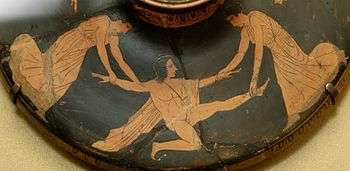
In the play The Bacchae by Euripides, Dionysus returns to his birthplace, Thebes, which is ruled by his cousin Pentheus. Pentheus, his mother Agave, and his aunts Ino and Autonoe do not believe that Dionysus is a son of Zeus. Despite the warnings of the blind prophet Tiresias, they deny him worship; instead, they arraign him for causing madness among the women of Thebes.
Dionysus uses his divine powers to drive Pentheus insane, then invites him to spy on the ecstatic rituals of the Maenads, in the woods of Mount Cithaeron. Pentheus, hoping to witness a sexual orgy, hides himself in a tree. The Maenads spot him; maddened by Dionysus, they take him to be a mountain-dwelling lion, and attack him with their bare hands. Pentheus' aunts, and his mother, Agave, are among them; they rip him limb from limb. Agave mounts his head on a pike, and takes the trophy to her father, Cadmus. The madness passes. Dionysus arrives in his true, divine form, banishes Agave and her sisters, and transforms Cadmus and his wife Harmonia into serpents. Only Tiresias is spared.[60]
Lycurgus
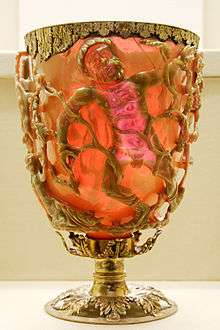
When King Lycurgus of Thrace heard that Dionysus was in his kingdom, he imprisoned Dionysus' followers, the Maenads. Dionysus fled and took refuge with Thetis, and sent a drought which stirred the people into revolt. Dionysus then drove King Lycurgus insane and had him slice his own son into pieces with an axe in the belief that he was a patch of ivy, a plant holy to Dionysus. An oracle then claimed that the land would stay dry and barren as long as Lycurgus was alive. His people had him drawn and quartered. Following the death of the king, Dionysus lifted the curse. This story is told in Homer's epic, Iliad 6.136-7. In an alternative version, sometimes shown in art, Lycurgus tries to kill Ambrosia, a follower of Dionysus, who was transformed into a vine that twined around the enraged king and restrained him, eventually killing him.[61]
Prosymnus

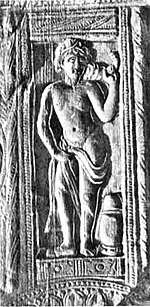
Dionysus was of the few Olympians with the power to remove deceased mortals from the underworld, and thus restore them to life. He descended to the underworld (Hades) to rescue his mother Semele, whom he had not seen since his birth, making the descent by way of a reputedly bottomless pool on the coast of the Argolid near the prehistoric site of Lerna, and bypassing Thanatos, the god of death. According to Clement of Alexandria, Dionysus was guided by Prosymnus or Polymnus, who requested, as his reward, to be Dionysus' lover. Dionysus returned Semele to Mount Olympus; but Prosymnus died before Dionysus could honor his pledge, so in order to satisfy Prosymnus' shade, Dionysus fashioned a phallus from an olive branch and sat on it at Prosymnus' tomb.[63] This story survives in full only in Christian sources whose aim was to discredit pagan mythology. It appears to have served to explain the secret objects of the Dionysian Mysteries.[64]
Ampelus
Another myth according to Nonnus involves Ampelus, a satyr, who was loved by Dionysus. As related by Ovid, Ampelus became the constellation Vindemitor, or the "grape-gatherer":
...not so will the Grape-gatherer escape thee. The origin of that constellation also can be briefly told. 'Tis said that the unshorn Ampelus, son of a nymph and a satyr, was loved by Bacchus on the Ismarian hills. Upon him the god bestowed a vine that trailed from an elm's leafy boughs, and still the vine takes from the boy its name. While he rashly culled the gaudy grapes upon a branch, he tumbled down; Liber bore the lost youth to the stars."[65]
Another story of Ampelus was related by Nonnus: in an accident foreseen by Dionysus, the youth was killed while riding a bull maddened by the sting of a gadfly sent by Atë, the Goddess of Folly. The Fates granted Ampelus a second life as a vine, from which Dionysus squeezed the first wine.[66]
Chiron
Young Dionysus was also said to have been one of the many famous pupils of the centaur Chiron. According to Ptolemy Chennus in the Library of Photius, "Dionysus was loved by Chiron, from whom he learned chants and dances, the bacchic rites and initiations."[67]
Secondary myths
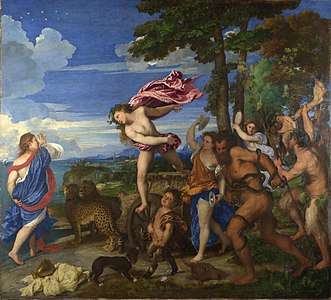
When Hephaestus bound Hera to a magical chair, Dionysus got him drunk and brought him back to Olympus after he passed out.
When Theseus abandoned Ariadne sleeping on Naxos, Dionysus found and married her. She bore him a son named Oenopion, but he committed suicide or was killed by Perseus. In some variants, he had her crown put into the heavens as the constellation Corona; in others, he descended into Hades to restore her to the gods on Olympus. Another different account claims Dionysus ordered Theseus to abandon Ariadne on the island of Naxos for he had seen her as Theseus carried her onto the ship and had decided to marry her.
A third descent by Dionysus to Hades is invented by Aristophanes in his comedy The Frogs. Dionysus, as patron of the Athenian dramatic festival, the Dionysia, wants to bring back to life one of the great tragedians. After a competition Aeschylus is chosen in preference to Euripides.
Psalacantha, a nymph, failed at winning the love of Dionysus as his main love interest at the moment was Ariadne, and ended up being changed into a plant.
Callirrhoe was a Calydonian woman who scorned Coresus, a priest of Dionysus, who threatened to afflict all the women of Calydon with insanity (see Maenad). The priest was ordered to sacrifice Callirhoe but he killed himself instead. Callirhoe threw herself into a well which was later named after her.
Consorts and children
- Ariadne
- Oenopion
- Staphylus
- Thoas
- Peparethus
- Phanus
- Eurymedon
- Euanthes
- Latramys
- Tauropolis
- Ceramus
- Circe
- Aura
- Iacchus
- twin of Iacchus, killed by Aura instantly upon birth
- Nicaea
- Araethyrea or Chthonophyle (or again Ariadne)
- Physcoa
- Narcaeus
- Pallene
- Carya
- Percote
- Priapus (possibly)[68]
- Chione, Naiad nymph
- Priapus (possibly)[69]
- Alexirrhoe
- Alphesiboea
- Medus
- Phthonus
- Althaea
- unnamed
- Thysa[70]
Symbolism
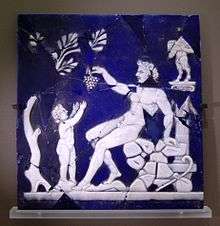
The bull, serpent, tiger, ivy, and wine are characteristic of Dionysian iconography. Dionysus is also strongly associated with satyrs, centaurs, and sileni. He is often shown riding a leopard, wearing a leopard skin, or in a chariot drawn by panthers, and may also be recognized by the thyrsus he carries. Besides the grapevine and its wild barren alter-ego, the toxic ivy plant, both sacred to him, the fig was also his symbol. The pinecone that tipped his thyrsus linked him to Cybele.
The Dionysia and Lenaia festivals in Athens were dedicated to Dionysus. On numerous vases (referred to as Lenaia vases), the god is shown participating in the ritual sacrifice as a masked and clothed pillar (sometimes a pole, or tree is used), while his worshipers eat bread and drink wine. Initiates worshipped him in the Dionysian Mysteries, which were comparable to and linked with the Orphic Mysteries, and may have influenced Gnosticism. Orpheus was said to have invented the Mysteries of Dionysus.[71]
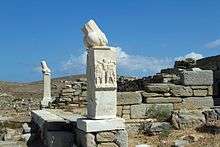
Dionysus was a god of resurrection and he was strongly linked to the bull. In a cult hymn from Olympia, at a festival for Hera, Dionysus is invited to come as a bull; "with bull-foot raging". Walter Burkert relates, "Quite frequently [Dionysus] is portrayed with bull horns, and in Kyzikos he has a tauromorphic image", and refers also to an archaic myth in which Dionysus is slaughtered as a bull calf and impiously eaten by the Titans.[13] In the Classical period of Greece, the bull and other animals identified with deities were separated from them as their agalma, a kind of heraldic show-piece that concretely signified their numinous presence.[13]
The snake and phallus were symbols of Dionysus in ancient Greece, and of Bacchus in Greece and Rome.[72][73][74] He typically wears a panther or leopard skin and carries a Thyrsus – a long stick or wand topped with a pine cone. His iconography sometimes include maenads, who wear wreaths of ivy and serpents around their hair or neck.[75][76][77]
The philosopher Heraclitus, unifying opposites, declared that Hades and Dionysus, the very essence of indestructible life (zoë), are the same god.[78] Among other evidence, Karl Kerényi notes in his book[79] that the Homeric Hymn "To Demeter",[80] votive marble images[81] and epithets[82] all link Hades to being Dionysus. He also notes that the grieving goddess Demeter refused to drink wine, as she states that it would be against themis for her to drink wine, which is the gift of Dionysus, after Persephone's abduction, because of this association; indicating that Hades may in fact have been a "cover name" for the underworld Dionysus.[83] He suggests that this dual identity may have been familiar to those who came into contact with the Mysteries.[84] One of the epithets of Dionysus was "Chthonios", meaning "the subterranean".[85]
Evidence for a cult connection is quite extensive, particularly in southern Italy, especially when considering the heavy involvement of death symbolism included in Dionysian worship;[86][87] statues of Dionysus[88][89] found in the Ploutonion at Eleusis gives further evidence as the statues found bare a striking resemblance to the statue of Eubouleus, also called Aides Kyanochaites (Hades of the flowing dark hair),[90][91][92] known as the youthful depiction of the Lord of the Underworld. The statue of Eubouleus is described as being radiant but disclosing a strange inner darkness[93][94] Ancient portrayals show Dionysus holding in his hand the kantharos, a wine-jar with large handles, and occupying the place where one would expect to see Hades. Archaic artist Xenocles portrayed on one side of a vase, Zeus, Poseidon and Hades, each with his emblems of power; with Hades' head turned back to front and, on the other side, Dionysus striding forward to meet his bride Persephone, with the kantharos in his hand, against a background of grapes.[95] Dionysus also shared several epithets with Hades such as Chthonios, Eubouleus and Euclius.
Both Hades and Dionysus were associated with a divine tripartite deity with Zeus.[96][97][98] The role of unifying Hades, Zeus and Dionysus as a single tripartite god was used to represent the birth, death and resurrection of a deity and to unify the 'shining' realm of Zeus and the dark underworld realm of Hades.[96][99]
In the Orphic tradition of ancient Greece, Dionysus Zagreus served as its patron god connected to death and immortality, and symbolized the one who guides reincarnation.[100]
Bacchus and the Bacchanalia
A mystery cult to Bacchus was brought to Rome from the Greek culture of southern Italy or by way of Greek-influenced Etruria. It was established around 200 BC in the Aventine grove of Stimula by a priestess from Campania, near the temple where Liber Pater ("The Free Father") had a State-sanctioned, popular cult. Liber was a native Roman god of wine, fertility, and prophecy, patron of Rome's plebeians (citizen-commoners) and a close equivalent to Bacchus-Dionysus Eleutherios.
The Bacchic rituals contained omophagic practices such as pulling live animals apart and eating the whole of them raw. This practice served not only as a reenactment of the infant death and rebirth of Bacchus, but also as a means by which Bacchic practitioners produced "enthusiasm": etymologically, to let a god enter the practitioner's body or to have her become one with Bacchus.[101][102]
In Livy's account, the Bacchic mysteries were a novelty at Rome; originally restricted to women and held only three times a year, they were corrupted by an Etruscan-Greek version, and thereafter drunken, disinhibited men and women of all ages and social classes cavorted in a sexual free-for-all five times a month. Livy relates their various outrages against Rome's civil and religious laws and traditional morality (mos maiorum); a secretive, subversive and potentially revolutionary counter-culture. Livy's sources, and his own account of the cult, probably drew heavily on the Roman dramatic genre known as "Satyr plays", based on Greek originals.[103][104] The cult was suppressed by the State with great ferocity; of the 7,000 arrested, most were executed. Modern scholarship treats much of Livy's account with skepticism; more certainly, a Senatorial edict, the Senatus consultum de Bacchanalibus was distributed throughout Roman and allied Italy. It banned the former Bacchic cult organisations. Each meeting must seek prior senatorial approval through a praetor. No more than three women and two men were allowed at any one meeting, Those who defied the edict risked the death penalty.
.jpg)
by John Reinhard Weguelin
Bacchus was conscripted into the official Roman pantheon as an aspect of Liber, and his festival was inserted into the Liberalia. In Roman culture, Liber, Bacchus and Dionysus became virtually interchangeable equivalents. Bacchus was euhemerised as a wandering hero, conqueror and founder of cities. He was a patron deity and founding hero at Leptis Magna, birthplace of the emperor Septimius Severus, who promoted his cult. In some Roman sources, the ritual procession of Bacchus in a tiger-drawn chariot, surrounded by maenads, satyrs and drunks, commemorates the god's triumphant return from the conquest of India. Pliny believed this to be the historical prototype for the Roman Triumph.[105]
In the arts
Classical art
_(3470740119).jpg)
The god, and still more often his followers, were commonly depicted in the painted pottery of Ancient Greece, much of which was vessels for wine. But, apart from some reliefs of maenads, Dionysian subjects rarely appeared in large sculpture before the Hellenistic period, when they became common.[106] In these, the treatment of the god himself ranged from severe archaising or Neo Attic types such as the Dionysus Sardanapalus to types showing him as an indolent and androgynous young man, often nude.[107] Hermes and the Infant Dionysus is probably a Greek original in marble, and the Ludovisi Dionysus group is probably a Roman original of the 2nd century AD. Well-known Hellenistic sculptures of Dionysian subjects, surviving in Roman copies, include the Barberini Faun, the Belvedere Torso, the Resting Satyr. The Furietti Centaurs and Sleeping Hermaphroditus reflect related subjects, which had by this time become drawn into the Dionysian orbit.[108] The marble Dancer of Pergamon is an original, as is the bronze Dancing Satyr of Mazara del Vallo, a recent recovery from the sea.
The Dionysian world by the Hellenistic period is a hedonistic but safe pastoral into which other semi-divine creatures of the countryside such as centaurs, nymphs, and the god Pan and Hermaphrodite have been co-opted.[109] Nymphs by this stage "means simply an ideal female of the Dionysian outdoors, a non-wild bacchant".[110] Hellenistic sculpture also includes for the first time large genre subjects of children and peasant, many of whom carry Dionysian attributes such as ivy wreaths, and "most should be seen as part of his realm. They have in common with satyrs and nymphs that they are creatures of the outdoors and are without true personal identity."[111] The 4th-century BC Derveni Krater, the unique survival of a very large scale Classical or Hellenistic metal vessel of top quality, depicts Dionysus and his followers.
Dionysus appealed to the Hellenistic monarchies for a number of reasons, apart from merely being a god of pleasure: He was a human who became divine, he came from, and had conquered, the East, exemplified a lifestyle of display and magnificence with his mortal followers, and was often regarded as an ancestor.[112] He continued to appeal to the rich of Imperial Rome, who populated their gardens with Dionysian sculpture, and by the 2nd century AD were often buried in sarcophagi carved with crowded scenes of Bacchus and his entourage.[113]
The 4th-century AD Lycurgus Cup in the British Museum is a spectacular cage cup which changes colour when light comes through the glass; it shows the bound King Lycurgus being taunted by the god and attacked by a satyr; this may have been used for celebration of Dionysian mysteries. Elizabeth Kessler has theorized that a mosaic appearing on the triclinium floor of the House of Aion in Nea Paphos, Cyprus, details a monotheistic worship of Dionysus.[114] In the mosaic, other gods appear but may only be lesser representations of the centrally imposed Dionysus. The mid-Byzantine Veroli Casket shows the tradition lingering in Constantinople around 1000 AD, but probably not very well understood.
Art from the Renaissance on
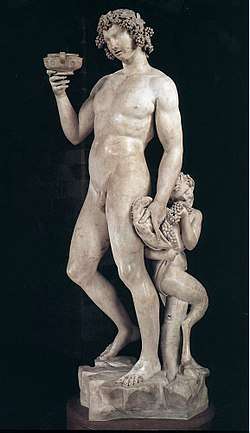


Bacchic subjects in art resumed in the Italian Renaissance, and soon became almost as popular as in antiquity, but his "strong association with feminine spirituality and power almost disappeared", as did "the idea that the destructive and creative powers of the god were indissolubly linked".[115] In Michelangelo's statue (1496–97) "madness has become merriment". The statue aspires to suggest both drunken incapacity and an elevated consciousness, but this was perhaps lost on later viewers, and typically the two aspects were thereafter split, with a clearly drunk Silenus representing the former, and a youthful Bacchus often shown with wings, because he carries the mind to higher places.[116]
Titian's Bacchus and Ariadne (1522–23) and The Bacchanal of the Andrians (1523-26), both painted for the same room, offer an influential heroic pastoral,[117] while Diego Velázquez in The Triumph of Bacchus (or Los borrachos - "the drinkers", c. 1629) and Jusepe de Ribera in his Drunken Silenus choose a genre realism. Flemish Baroque painting frequently painted the Bacchic followers, as in Van Dyck's Drunken Silenus and many works by Rubens; Poussin was another regular painter of Bacchic scenes.[118] Depictions of the proverb Sine Cerere et Baccho friget Venus were a particular feature of Northern Mannerism, but the subject was also painted several times by Rubens. Because of his association with the vine harvest, Bacchus became the god of autumn, and he and his followers were often shown in sets depicting the seasons.[119]
Modern literature and philosophy
Dionysus has remained an inspiration to artists, philosophers and writers into the modern era. In The Birth of Tragedy (1872), the German philosopher Friedrich Nietzsche proposed that a tension between Apollonian and Dionysian aesthetic principles underlay the development of Greek tragedy; Dionysus represented what was unrestrained chaotic and irrational, while Apollo represented the rational and ordered. Nietzsche claimed that the oldest forms of Greek Tragedy were entirely based on suffering of Dionysus. In Nietzsche's 1886 work Beyond Good and Evil, and later works The Twilight of the Idols, The Antichrist and Ecce Homo, Dionysus is conceived as the embodiment of the unrestrained will to power.
In The Hellenic Religion of the Suffering God (1904), and Dionysus and Early Dionysianism (1921), the poet Vyacheslav Ivanov elaborates the theory of Dionysianism, tracing the origins of literature, and tragedy in particular, to ancient Dionysian mysteries. Károly Kerényi characterizes Dionysus as representative of the psychological life force (Greek Zoê).[120] Other psychological interpretations place Dionysus' emotionality in the foreground, focusing on the joy, terror or hysteria associated with the god.[121][122][123][124][125] Sigmund Freud specified that his ashes should be kept in an Ancient Greek vase painted with Dionysian scenes from his collection, which remains on display at Golders Green Crematorium in London.
In CS Lewis' Prince Caspian (part of The Chronicles of Narnia), Bacchus is a dangerous-looking, androgynous young boy who helps Aslan awaken the spirits of the Narnian trees and rivers. Rick Riordan's series of books Percy Jackson & The Olympians presents Dionysus as an uncaring, childish and spoiled god. In the novel Household Gods by Harry Turtledove and Judith Tarr, Nicole Gunther-Perrin is a lawyer in the 20th century. She makes a libation to Liber and Libera, Roman equivalents of Dionysus and Persephone, and is transported back in time to ancient Rome.[126][127] In The Secret History by Donna Tartt, a group of classics students reflect on reviving the worship of Dionysus during their time in college.[128]
Modern film and performance art
Walt Disney uses a modernised version of Silenus, Dionysus or Bacchus in the "Pastoral" segment of the animated film Fantasia. In 1969, an adaption of The Bacchae was performed, called Dionysus in '69. A film was made of the same performance. The production was notable for involving audience participation, nudity, and theatrical innovations.[129] In 1974, Stephen Sondheim and Burt Shevelove adapted Aristophanes' comedy The Frogs into a modern musical, which hit broadway in 2004 and was revived in London in 2017. The musical keeps the descent of Dionysus into Hades to bring back a playwright, however the playwrights are updated to modern times, and Dionysus is forced to choose between George Bernard Shaw and William Shakespeare.[130]
Worship after Christianization of Europe
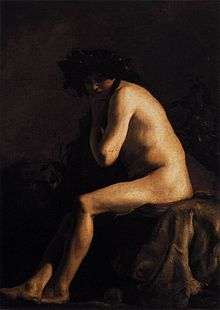
Though the last known worshippers of Greek gods were converted before 1000 AD, there were instances of revived worship of Dionysus afterwards, and finally with the rise of neopaganism, worship of the god has once again been revived.
During Easter in 1282 in Scotland, the parish priest of Inverkeithing led young women in a dance in honor of Dionysus. He danced and sang at the front, carrying a representation of the phallus on a pole. He was killed by a Christian mob later that year.[131] The late medieval Byzantine scholar Gemistus Pletho secretly advocated in favor of a return to paganism in medieval Greece.[132]
In the 18th century, Hellfire Clubs sprung up in Britain and Ireland. Though activities varied between the clubs, some of them were very pagan, and included shrines and sacrifices. Dionysus was one of the most popular deities, alongside deities like Venus and Flora. Today one can still see the statue of Dionysus left behind in the Hellfire Caves.[133]
In 1820, Ephraim Lyon founded the Church of Bacchus in Eastford, Connecticut. He declared himself High Priest, and added local drunks to the list of membership. He maintained that those who died as members would go to a Bacchanalia for their afterlife.[134]
Modern followers of Dionysus may offer the god wine, grapes, ivy, and various forms of incense. They may also celebrate Roman festivals such as the Liberalia (March 17, close to the Spring Equinox) or Bacchanalia (Various dates), and various Greek festivals such as the Anthesteria, Lenaia, and the Greater and Lesser Dionysias, calculated by lunar calendar.[135]
Parallels with Christianity
Numerous scholars have compared narratives surrounding the Christian figure of Jesus with those associated with Dionysus.
Death and Resurrection
Some scholars of comparative mythology identify both Dionysus and Jesus with the dying-and-returning god mythological archetype.[13] On the other hand, it has been noted that the details of Dionysus' death and rebirth are starkly different both in content and symbolism from Jesus. The two stories take place in very different historical and geographic contexts. Also, the manner of death is different; in the most common myth, Dionysus was torn to pieces and eaten by the titans, but "eventually restored to a new life" from the heart that was left over.[136][137]
Trial

Another parallel can be seen in The Bacchae where Dionysus appears before King Pentheus on charges of claiming divinity, which is compared to the New Testament scene of Jesus being interrogated by Pontius Pilate.[138][139][140] However, a number of scholars dispute this parallel, since the confrontation between Dionysus and Pentheus ends with Pentheus dying, torn into pieces by the mad women, whereas the trial of Jesus ends with him being sentenced to death. The discrepancies between the two stories, including their resolutions, have led many scholars to regard the Dionysus story as radically different from the one about Jesus, except for the parallel of the arrest, which is a detail that appears in many biographies as well.[141]
Sacred Food and Drink
Other elements, such as the celebration by a ritual meal of bread and wine, also have parallels.[139] The omophagia was the Dionysian act of eating raw flesh and drinking wine to consume the god. Within Orphism, it was believed that consuming the meat and wine was symbolic of the Titans eating the flesh (meat) and blood (wine) of Dionysus and that, by participating in the omophagia, Dionysus' followers could achieve communion with the god. Powell, in particular, argues that precursors to the Catholic notion of transubstantiation can be found in Dionysian religion.[139]
Other parallels
E. Kessler has argued that the Dionysian cult developed into strict monotheism by the 4th century AD; together with Mithraism and other sects, the cult formed an instance of "pagan monotheism" in direct competition with Early Christianity during Late Antiquity.[142] Scholars from the 16th century onwards, especially Gerard Vossius, also discussed the parallels between the biographies of Dionysus/Bacchus and Moses (Vossius named his sons Dionysius and Isaac). Such comparisons surface in details of paintings by Poussin.[143]
Genealogy
| Dionysus' family tree |
|---|
Gallery
 Roman marble sarcophagus with the Triumph of Dionysos and the Seasons (circa 260–270 AD)
Roman marble sarcophagus with the Triumph of Dionysos and the Seasons (circa 260–270 AD).jpg) Triumph of Dionysus
Triumph of Dionysus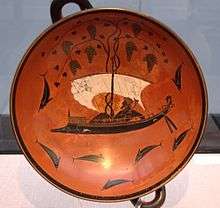 The Dionysus Cup, a 6th-century BC kylix with Dionysus sailing with the pirates he transformed to dolphins
The Dionysus Cup, a 6th-century BC kylix with Dionysus sailing with the pirates he transformed to dolphins The winged daimon Dionysus riding a tiger, from the House of Dionysus in Delos, Greece, Hellenistic mosaic from the 2nd century BC
The winged daimon Dionysus riding a tiger, from the House of Dionysus in Delos, Greece, Hellenistic mosaic from the 2nd century BC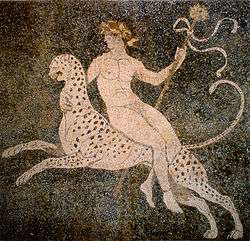
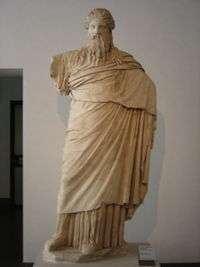 Statue of Dionysus (Sardanapalus) (Museo Palazzo Massimo Alle Terme, Rome)
Statue of Dionysus (Sardanapalus) (Museo Palazzo Massimo Alle Terme, Rome)- Bronze head of Dionysus (50 BC - 50 AD) in the British Museum[149]
- Statue of Dionysus in Remich Luxembourg
 A Bacchus themed table - the top was made in Florence (c. 1736) and the gilded wood base in Britain or Ireland (circa 1736–1740).
A Bacchus themed table - the top was made in Florence (c. 1736) and the gilded wood base in Britain or Ireland (circa 1736–1740)..jpg) Bacchus - Hendrick Goltzius (1592)
Bacchus - Hendrick Goltzius (1592) Dionysian amphora
Dionysian amphora Dionysian jug
Dionysian jug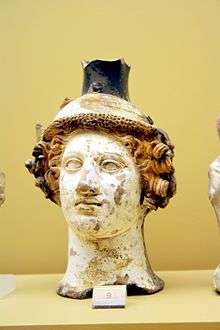 Terracotta vase in the shape of Dionysus' head (circa 410 BC) - on display in the Ancient Agora Museum in Athens, housed in the Stoa of Attalus
Terracotta vase in the shape of Dionysus' head (circa 410 BC) - on display in the Ancient Agora Museum in Athens, housed in the Stoa of Attalus
See also
Notes
- ↑ Another variant, from the Spanish royal collection, is at the Museo del Prado, Madrid: illustration.
- ↑ Hedreen, Guy Michael. Silens in Attic Black-figure Vase-painting: Myth and Performance. University of Michigan Press. 1992. ISBN 9780472102952. page 1
- ↑ James, Edwin Oliver. The Tree of Life: An Archaeological Study. Brill Publications. 1966. page 234. ISBN 9789004016125
- ↑ Gately, Iain (2008). Drink. Gotham Books. p. 11. ISBN 978-1-592-40464-3.
- ↑ Ferguson, Everett (2003). Backgrounds of Early Christianity. Wm. B. Eerdmans Publishing. ISBN 9780802822215.
- ↑ He appears as a likely theonym (divine name) in Linear B tablets as di-wo-nu-so (KH Gq 5 inscription)
- 1 2 Raymoure, K.A. (November 2, 2012). "Khania Linear B Transliterations". Minoan Linear A & Mycenaean Linear B. Deaditerranean. "Possible evidence of human sacrifice at Minoan Chania". Archaeology News Network. 2014. Raymoure, K.A. "Khania KH Gq Linear B Series". Minoan Linear A & Mycenaean Linear B. Deaditerranean. "KH 5 Gq (1)". DĀMOS: Database of Mycenaean at Oslo. University of Oslo.
- ↑ Kerenyi 1976.
- ↑ Thomas McEvilley, The Shape of Ancient Thought, Allsworth press, 2002, pp. 118–121. Google Books preview
- ↑ Reginald Pepys Winnington-Ingram, Sophocles: an interpretation, Cambridge University Press, 1980, p.109 Google Books preview
- ↑ Zofia H. Archibald, in Gocha R. Tsetskhladze (Ed.) Ancient Greeks west and east, Brill, 1999, p.429 ff.Google Books preview
- ↑ Sacks, David; Murray, Oswyn; Brody, Lisa R. (2009-01-01). Encyclopedia of the Ancient Greek World. Infobase Publishing. ISBN 9781438110202. Retrieved 20 April 2013.
- 1 2 3 4 5 Burkert, Walter, Greek Religion, 1985 pp. 64, 132
- ↑ Otto, Walter F. (1995). Dionysus Myth and Cult. Indiana University Press. ISBN 0-253-20891-2.
- ↑ Gods of Love and Ecstasy, Alain Danielou p.15
- ↑ In Greek "both votary and god are called Bacchus". Burkert, Greek Religion 1985:162. For the initiate as Bacchus, see Euripides, Bacchantes 491. For the god, who alone is Dionysus, see Sophocles, Oedipus Rex 211 and Euripides, Hippolytus 560.
- ↑ Sutton, p.2, mentions Dionysus as The Liberator in relation to the city Dionysia festivals. In Euripides, Bacchae 379–385: "He holds this office, to join in dances, [380] to laugh with the flute, and to bring an end to cares, whenever the delight of the grape comes at the feasts of the gods, and in ivy-bearing banquets the goblet sheds sleep over men."
- ↑ Xavier Riu, Dionysism and Comedy, Rowman and Littlefield, 1999, p.105
- ↑ John Chadwick, The Mycenaean World, Cambridge University Press, 1976, 99ff: "But Dionysos surprisingly appears twice at Pylos, in the form Diwonusos, both times irritatingly enough on fragments, so that we have no means of verifying his divinity."
- ↑ "The Linear B word di-wo-nu-so". Palaeolexicon. Word study tool of ancient languages.
- ↑ This is the view of Garcia Ramon (1987) and Peters (1989), summarised and endorsed in Janda (2010:20).
- ↑ Fox, p. 217, "The word Dionysos is divisible into two parts, the first originally Διος (cf. Ζευς), while the second is of an unknown signification, although perhaps connected with the name of the Mount Nysa which figures in the story of Lykourgos: (...) when Dionysos had been reborn from the thigh of Zeus, Hermes entrusted him to the nymphs of Mount Nysa, who fed him on the food of the gods, and made him immortal."
- ↑ Testimonia of Pherecydes in an early 5th-century BC fragment, FGrH 3, 178, in the context of a discussion on the name of Dionysus: "Nũsas (acc. pl.), he [Pherecydes] said, was what they called the trees."
- 1 2 Nonnus, Dionysiaca 9.20–24.
- ↑ Suda s.v. Διόνυσος .
- ↑ R. S. P. Beekes, Etymological Dictionary of Greek, Brill, 2009, p. 337.
- ↑ see Janda (2010), 16-44 for a detailed account.
- ↑ Pausanias, 8.39.6.
- ↑ Stephanus of Byzantium, s.v. Ακρωρεία
- ↑ Used thus by Ausonius, Epigrams, 29, 6, and in Catullus, 29; see Lee M. Fratantuono, NIVALES SOCII: CAESAR, MAMURRA, AND THE SNOW OF CATULLUS C. 57, Quaderni Urbinati di Cultura Classica, New Series, Vol. 96, No. 3 (2010), p. 107, Note 2.
- ↑ Aego'bolus entry in William Smith, A Dictionary of Greek and Roman biography and mythology, London, John Murray, 1848, citing Pausanias, ix. 8. § 1. Online at perseus.tufts.edu (accessed 15 February 2017)
- ↑ Erwin Rohde, Psyché, p. 269
- ↑ Aristid.Or.41
- ↑ Macr.Sat.I.18.9
- ↑ For a parallel see pneuma/psuche/anima The core meaning is wind as "breath/spirit"
- ↑ Bulls in antiquity were said to roar.
- ↑ Blackwell, Christopher W.; Blackwell, Amy Hackney (2011-03-21). Mythology For Dummies. John Wiley & Sons. ISBN 9781118053874.
- ↑ McKeown, J.C. A Cabinet of Greek Curiosities: Strange Tales and Surprising Facts from the Cradle of Western Civilization, Oxford University Press, New York, 2013, p. 210)
- ↑ Clement of Alexandria, Exhortation to the Greeks, 92: 82-83, Loeb Classical Library (registration required: accessed 17 December 2016)
- ↑ Kerenyi, C. (1967). Eleusis: Archetypal Image of Mother and Daughter. Princeton University Press. ISBN 0-691-01915-0; Kerenyi 1976). Dionysos: Archetypal Image of Indestructible Life. Princeton University Press.
- ↑ Janda (2010), 16-44.
- ↑ Kerenyi 1976:286.
- ↑ Jameson 1993, 53. Cf.n16 for suggestions of Devereux on "Enorkhes,"
- ↑ http://www.perseus.tufts.edu/hopper/morph?l=%CE%BB%CF%85%CE%B1%CE%B9%CE%BF%CF%82&la=greek#lexicon Liddell-Scott-Jones Greek-English Lexicon
- ↑ Liddell-Scott-Jones Greek-English Lexicon
- ↑ Mentioned by Erasmus in The Praise of Folly
- ↑ Rosemarie Taylor-Perry, The God Who Comes: Dionysian Mysteries Revisited. Algora Press 2003, p.89, cf. Sabazius.
- ↑ "Sarcophagus Depicting the Birth of Dionysus". The Walters Art Museum.
- ↑ Diorodus V 75.4, noted by Karl Kerényi, Dionysos: Archetypal Image of Indestructible Life (Princeton University Press) 1976, "The Cretan core of the Dionysos myth" p 110 note 213 and pp 110-114.
- ↑ Diodorus III 64.1, also noted by Kerény (110 note 214).
- ↑ Damascius, Commentary on the Phaedo, I, 170, see in translation Westerink, The Greek Commentaries on Plato's Phaedo, vol. II (The Prometheus Trust, Westbury) 2009
- ↑ Damascius, Commentary on the Phaedo, I, 1-13 and 165-172, see in translation Westerink, The Greek Commentaries on Plato's Phaedo, vol. II, The Prometheus Trust, Westbury, 2009
- ↑ Apollodorus, The Library, with an English Translation by Sir James George Frazer, F.B.A., F.R.S. in 2 Volumes. Cambridge, Massachusetts, Harvard University Press; London, William Heinemann Ltd. 1921. Includes Frazer's notes. ISBN 0-674-99135-4, ISBN 0-674-99136-2
- ↑ Conner, Nancy. "The Everything Book of Classical Mythology" 2ed
- ↑ Bull, 255
- ↑ Arrian, Anabasis, 5.1.1-2.2
- ↑ Bull, 253
- ↑ "Theoi.com" Homeric Hymn to Dionysus". Theoi.com. Retrieved 2014-06-29.
- ↑ Bull, 245-247, 247 quoted
- ↑ Euripides. The Bacchae. https://records.viu.ca/~johnstoi/euripides/euripides.htm. (original Greek text available at http://www.perseus.tufts.edu/hopper/text?doc=Perseus:text:1999.01.0091)
- ↑ "British Museum - The Lycurgus Cup". britishmuseum.org.
- ↑ Varadpande, M. L. (1981). Ancient Indian And Indo-Greek Theatre. Abhinav Publications. p. 91-93. ISBN 9788170171478.
- ↑ Clement of Alexandria, Protreptikos, II-30 3-5
- ↑ Arnobius, Against the Gentiles 5.28 (Dalby 2005, pp. 108–117)
- ↑ Ovid, Fasti, iii. 407 ff. (James G. Frazer, translator).
- ↑ Nonnus, Dionysiaca, x. 175–430; xi, xii. 1–117 (Dalby 2005, pp. 55–62).
- ↑ Photius, Library; "Ptolemy Chennus, New History"
- ↑ Hesychius of Alexandria s. v. Priēpidos
- ↑ Scholia on Theocritus, Idyll 1. 21
- ↑ Strabo, Geography, 10.3.13, quotes the non-extant play Palamedes which seems to refer to Thysa, a daughter of Dionysus, and her (?) mother as participants of the Bacchic rites on Mount Ida, but the quoted passage is corrupt.
- ↑ Pseudo-Apollodorus, Bibliotheca Library and Epitome, 1.3.2. "Orpheus also invented the mysteries of Dionysus, and having been torn in pieces by the Maenads he is buried in Pieria."
- ↑ James Charlesworth (2010). The Good And Evil Serpent: How a Universal Symbol Became Christianized. Yale University Press. pp. 222–223. ISBN 978-0-300-14273-0.
- ↑ Walter Friedrich Otto; Robert B. Palmer (1965). Dionysus: Myth and Cult. Indiana University Press. pp. 164–166. ISBN 0-253-20891-2.
- ↑ Leo Steinberg (2014). The Sexuality of Christ in Renaissance Art and in Modern Oblivion. University of Chicago Press. pp. 47, 83 with footnotes. ISBN 978-0-226-22631-6.
- ↑ Jennifer R. March (2014). Dictionary of Classical Mythology. Oxbow. pp. 164, 296. ISBN 978-1-78297-635-6.
- ↑ Csapo, Eric (1997). "Riding the Phallus for Dionysus: Iconology, Ritual, and Gender-Role De/Construction". Phoenix. 51 (3/4): 256–257, 253–295. doi:10.2307/1192539.
- ↑ Dietrich, B. C. (1958). "Dionysus Liknites". The Classical Quarterly. Cambridge University Press. 8 (3–4): 244–248. Retrieved 2016-09-27.
- ↑ Heraclitus, encountering the festival of the Phallophoria, in which phalli were paraded about, remarked in a surviving fragment: "If they did not order the procession in honor of the god and address the phallus song to him, this would be the most shameless behavior. But Hades is the same as Dionysos, for whom they rave and act like bacchantes", Kerényi 1976, pp. 239–240.
- ↑ Kerényi, Karl (1991). Eleusis: Archetypal Image of Mother and Daughter. Princeton University Press. ISBN 9780691019154.
- ↑ Summary of Karl Kerenyi: "The Hymn tells us that Persephone was abducted in Nysion pedion, or the Nysian Plain, a plain that was named after the Dionysian mountain of Nysa. Nysa was regarded as the birthplace and first home of Dionysus. The divine marriage of Plouton and Persephone was celebrated on 'the meadow'. The dangerous region that Kore let herself be lured to in search of flowers was likely not originally connected to Plouton but to Dionysus, as Dionysus himself had the strange surname of 'the gaping one', though despite this the notion that the wine god in his quality as the Lord of the Underworld does not appear on the surface of the hymn. People would not be able to detect the hidden meaning it if it wasn’t for archaic vase portrayals." Eleusis: Archetypal Image of Mother and Daughter [P. 34, 35,]. "The Hymn to Demeter later mentions that Queen Metaneira of Eleusis later offers the disguised Demeter a beaker of sweet wine, something that Demeter refuses on the grounds that it would be against themis, the very nature of order and justice, for her to drink red wine and she instead invents a new beverage called kykeon to drink instead. The fact that Demeter refuses to drink wine on the grounds that it would be against themis indicates that she is well aware of who Persephone's abductor is, that it is the Subterranean cover name of Dionysus. The critic of the mysteries, the severe philosopher Herakleitos once declared "Hades is the same as Dionysos." The subterranean wine god was the ravisher, so how could Demeter accept something that was his gift to mankind" [P. 40]
- ↑ Summary of Karl Kerenyi: "The book later refers to Herakles initiation into the Eleusinian Mysteries so that he may enter the Underworld. In the iconography after his initiation Herakles in shown wearing a fringed white garment with a Dionysian deerskin thrown over it. Kore is shown with her mother Demeter and a snake twined around the Mystery basket, foreshadowing the secret, as making friends with snakes was Dionysian [P. 58]. The god of the Anthesteria was Dionysus, who celebrated his marriage in Athens amid flowers, the opening of wine jars, and the rising up of the souls of the dead [P. 149]. There are two reliefs in a marble votive relief of the fourth century BCE. One depicts Kore crowning her mother Demeter, the deities at the second altar are Persephone and her husband Dionysus as the recumbent god has the features of the bearded Dionysus rather than of Plouton. In his right hand, he raises not a cornucopia, the symbol of wealth, but a wine vessel and in his left, he bears the goblet for the wine. Over their heads an inscription reads "To the God and Goddess" [P. 151, 152]. The fragments of a gilded jar cover of the Kerch type show Dionysus, Demeter, little Ploutos, Kore, and a curly-haired boy clad in a long garment, one of the first son's of the Eleusinian king who was the first to be initiated. On another vase, Dionysus sits on his omphalos with his thryrsos in his left hand, sitting opposite Demeter, looking at each other severely. Kore is shown moving from Demeter towards Dionysus, as if trying to reconcile them [P. 162]. Eleusis: Archetypal Image of Mother and Daughter
- ↑ Summary of Karl Kerenyi: Kore and Thea are two different duplications of Persephone; Plouton and Theos are duplications of the subterranean Dionysus. The duplication of the mystery god as subterranean father and subterranean son, as Father Zagreus and the child Zagreus, husband and son of Persephone, has more to do with the mysteries of Dionysus than with the Eleusinian Mysteries. But a duplication of the chthonian, mystical Dionysus is provided even by his youthful aspect, which became distinguished and classical as the son of Semele from the son of Persephone. Semele, though not of Eleusinian origin, is also a double of Persephone [P. 155]. Eleusis: Archetypal Image of Mother and Daughter
- ↑ Kerényi 1967, p. 40.
- ↑ Kerényi 1976, p. 240.
- ↑ Kerényi 1976, pp. 83, 199.
- ↑ Loyd, Alan B (2009). What is a God?: Studies in the Nature of Greek Divinity. The Classical Press of Wales. ISBN 1905125356.
- ↑ Alan B Loyd: "The identification of Hades and Dionysus does not seem to be a particular doctrine of Herakleitos, nor does it commit him to monotheism. The evidence for a cult connection between the two is quite extensive, particularly in Southern Italy, and the Dionysiac mysteries are associated with death rituals."
- ↑ http://www.my-favourite-planet.de/images/people/d-01/dionysus/athens_dj-28082013-2-0833c_dionysus-eleusis.jpg
- ↑ http://www.my-favourite-planet.de/images/people/d-01/dionysus/athens_dj-28082013-2-0826d_dionysus-eleusis.jpg
- ↑
- ↑ Summary of Karl Kerenyi: These attempts at a reconstruction would remain very fragmentary were we not, in conclusion, to look attentively into the face of the god Eubouleus. The Lord of the Underworld bore this name in the youthful form represented in the statue, ascribed to Praxiteles, which is now in the National Museum at Athens and probably stood originally in the place where it was found, the Ploutonion. This youth is Plouton himself- radiant but disclosing a strange inner darkness- and at the same time his double and servant, comparable to Hermes or Pais besides Kabeiros or Theos [Page: 172]. ... The plentiful hair or long curls suggest rather Hades kyanochaites, Hades of the dark hair [Page:173].
- ↑ p. 172.
- ↑ Kerényi, Karl (1991). Eleusis: Archetypal Image of Mother and Daughter. Princeton University Press. ISBN 9780691019154.
- ↑ Summary of Karl Kerenyi: These attempts at a reconstruction would remain very fragmentary were we not, in conclusion, to look attentively into the face of the god Eubouleus. The Lord of the Underworld bore this name in the youthful form represented in the statue, ascribed to Praxiteles, which is now in the National Museum at Athens and probably stood originally in the place where it was found, the Ploutonion. This youth is Plouton himself- radiant but disclosing a strange inner darkness- and at the same time his double and servant, comparable to Hermes or Pais besides Kabeiros or Theos [Page: 172]. ... The plentiful hair or long curls suggest rather Hades kyanochaites, Hades of the dark hair [Page:173].
- ↑ http://www.perseus.tufts.edu/hopper/artifact?name=London+B+425&object=Vase
- 1 2 Taylor-Perry, Rosemarie (2003). The God who Comes: Dionysian Mysteries Revisited. Barnes & Noble. pp. 4, 22, 91, 92, 94, 168. ISBN 9780875862309.
- ↑ Rigoglioso, Marguerite (2010). Virgin Mother Goddesses of Antiquity. Palgrave Macmillan. ISBN 978-0-230-11312-1.
- ↑ Marguerite Rigoglioso "Given that Zeus was also sometimes portrayed as having an incarnation in the underworld that was closely identified with Hades, we can read here that Zeus and Hades were essentially two representations of the same god. ... The idea of Hades equals Dionysus, and that this dual god impregnated Persephone in the Eleusinian tradition, therefore, is in perfect accord with the story that Zeus impregnated her with Dionysus in Orphic myth, given that Hades equals Zeus, as well. Moreover, what we see from this esoteric complex is that, in seeding Persephone, Zeus/Hades/Dionysus created what Kerenyi perceptively calls "a second, a little Dionysus," a "subterranean Zeus." (Virgin Mother Goddesses of Antiquity)
- ↑ Rosemarie Taylor-Perry: "“Interestingly it is often mentioned that Zeus, Hades and Dionysus were all attributed to being the exact same god… Being a tripartite deity Hades is also Zeus, doubling as being the Sky God or Zeus, Hades abducts his 'daughter' and paramour Persephone. The taking of Kore by Hades is the act which allows the conception and birth of a second integrating force: Iacchos (Zagreus-Dionysus), also known as Liknites, the helpless infant form of that Deity who is the unifier of the dark underworld (chthonic) realm of Hades and the Olympian ("Shining") one of Zeus."
- ↑ Norman C. McClelland (2010). Encyclopedia of Reincarnation and Karma. McFarland. pp. 76–77. ISBN 978-0-7864-5675-8.
- ↑ Russell, Bertrand. History of Western Philosophy.Routledge, 1996, p. 25
- ↑ Kraemer, Ross S. "Ecstasy and Possession: The Attraction of Women to the Cult of Dionysus." The Harvard Theological Review, Vol. 72 60 Jan.-Apr. 1979.
- ↑ ..."the Bacchic passages in the Roman drama, taken over from their Greek models, presented a pejorative image of the Bacchic cult which predisposed the Romans towards persecution before the consul denounced the cult in 186." Robert Rouselle, Liber-Dionysus in Early Roman Drama, The Classical Journal, 82, 3 (1987), p. 193.
- ↑ "Certainly it is hard to imagine anything less consistent with Roman mos maiorum than the anarchic hedonism of satyrs. It was precisely libido, that morally subversive aspect of the Bacchic cult, that led to its brutal suppression..." Wiseman, T.P., "Satyrs in Rome? The Background to Horace's Ars Poetica," Journal of Roman Studies, 1988, p. 1. (accessed November 19, 2017)
- ↑ Pliny attributes the invention of the triumph to "Father Liber" (who by Pliny's time was identified with Bacchus and Dionysus): see Pliny, Historia Naturalis, 7.57 (ed. Bostock) at Perseus: Tufts.edu
- ↑ Smith, 127–129
- ↑ as in the Dionysus and Eros, Naples Archeological Museum
- ↑ Smith, 127–154
- ↑ Smith, 127, 131, 133
- ↑ Smith, 130
- ↑ Smith, 136
- ↑ Smith, 127
- ↑ Smith, 128
- ↑ Kessler, E., Dionysian Monotheism in Nea Paphos, Cyprus,
- ↑ Bull, 227-228, both quoted
- ↑ Bull, 228-232, 228 quoted
- ↑ Bull, 235-238, 242, 247-250
- ↑ Bull, 233-235
- ↑ Bull, 255-256
- ↑ Kerenyi, K., Dionysus: Archetypal Image of Indestructible Life (Princeton/Bollingen, 1976).
- ↑ Jeanmaire, H. Dionysus: histoire du culte de Bacchus, (p.106ff) Payot, (1951)
- ↑ Johnson, R. A. 'Ecstasy; Understanding the Psychology of Joy' HarperColling (1987)
- ↑ Hillman, J. 'Dionysus Reimagined' in The Myth of Analysis (pp.271-281) HarperCollins (1972); Hillman, J. 'Dionysus in Jung's Writings' in Facing The Gods, Spring Publications (1980)
- ↑ Thompson, J. 'Emotional Intelligence/Imaginal Intelligence' in Mythopoetry Scholar Journal, Vol 1, 2010
- ↑ Lopez-Pedraza, R. 'Dionysus in Exile: On the Repression of the Body and Emotion', Chiron Publications (2000)
- ↑ Johnson, Sarah. "Household Gods". Historical Novel Society. Historical Novel Society. Retrieved 2 August 2017.
- ↑ Horton, Rich. "Household Gods". SF Site. SF Site. Retrieved 2 August 2017.
- ↑ Kakutani, Michiko. "Books of The Times; Students Indulging in Course of Destruction". The New York Times. The New York Times. Retrieved 3 November 2017.
- ↑ Greenspun, Roger (March 23, 1970). "Screen::De Palma's 'Dionysus in 69'". New York Times. Retrieved 1 August 2017.
- ↑ Murray, Matthew. "The Frogs". Talkin' Broadway. Talkin' Broadway. Retrieved 2 August 2017.
- ↑ Maxwell, Herbert (1913). The Chronicle of Lanercost, 1272-1346. Glasgow, Scotland: Glasgow : J. Maclehose. pp. 29–30.
|access-date=requires|url=(help) - ↑ Clogg, Richard (Jan 2005). "Woodhouse, Christopher Montague, fifth Baron Terrington (1917–2001)". Oxford Dictionary of National Biography. Oxford, England: Oxford University Press. ISBN 978-0199671540.
- ↑ Ashe, Geoffrey (2000). The Hell-Fire Clubs: A History of Anti-Morality. Gloucestershire: Sutton Publishing. p. 114.
|access-date=requires|url=(help) - ↑ Bayles, Richard (1889). History of Windham County, Connecticut.
- ↑ "Dionysus". Neokoroi.org. Neokoroi. Retrieved 3 August 2017.
- ↑ Detienne, Marcel. Dionysus Slain. Baltimore: Johns Hopkins, 1979.
- ↑ Evans, Arthur. The God of Ecstasy. New York: St. Martins' Press, 1989
- ↑ Wick, Peter (2004). "Jesus gegen Dionysos? Ein Beitrag zur Kontextualisierung des Johannesevangeliums". Biblica. Rome: Pontifical Biblical Institute. 85 (2): 179–198. Retrieved 2007-10-10.
- 1 2 3 Powell, Barry B., Classical Myth. Second ed. With new translations of ancient texts by Herbert M. Howe. Upper Saddle River, New Jersey: Prentice-Hall, Inc., 1998.
- ↑ Studies in Early Christology, by Martin Hengel, 2005, p. 331 ( ISBN 0567042804).
- ↑ Dalby, Andrew (2005). The Story of Bacchus. London: British Museum Press.
- ↑ E. Kessler, Dionysian Monotheism in Nea Paphos, Cyprus. Symposium on Pagan Monotheism in the Roman Empire, Exeter, 17–20 July 2006 Abstract Archived 2008-04-21 at the Wayback Machine.)
- ↑ Bull, 240-241
- ↑ According to Homer, Aphrodite was the daughter of Zeus (Iliad 3.374, 20.105; Odyssey 8.308, 320) and Dione (Iliad 5.370–71), see Gantz, pp. 99–100.
- ↑ According to Homer, Iliad 1.570–579, 14.338, Odyssey 8.312, Hephaestus was apparently the son of Hera and Zeus, see Gantz, p. 74.
- ↑ According to Hesiod's Theogony 886–890, of Zeus' children by his seven wives, Athena was the first to be conceived, but the last to be born; Zeus impregnated Metis then swallowed her, later Zeus himself gave birth to Athena "from his head", see Gantz, pp. 51–52, 83–84.
- ↑ According to Hesiod, Theogony 183–200, Aphrodite was born from Uranus' severed genitals, see Gantz, pp. 99–100.
- ↑ According to Hesiod, Theogony 927–929, Hephaestus was produced by Hera alone, with no father, see Gantz, p. 74.
- ↑ "British Museum - statue". British Museum.
References
- Bull, Malcolm, The Mirror of the Gods, How Renaissance Artists Rediscovered the Pagan Gods, Oxford UP, 2005, ISBN 9780195219234
- Dalby, Andrew (2005). The Story of Bacchus. London: British Museum Press. ISBN 0-7141-2255-6.
- Farnell, Lewis Richard, The Cults of the Greek States, 1896. Volume V, cf. Chapter IV, "Cults of Dionysos"; Chapter V, "Dionysiac Ritual"; Chapter VI, "Cult-Monuments of Dionysos"; Chapter VII, "Ideal Dionysiac Types".
- Fox, William Sherwood, The Mythology of All Races, v.1, Greek and Roman, 1916, General editor, Louis Herbert Gray.
- Gantz, Timothy, Early Greek Myth: A Guide to Literary and Artistic Sources, Johns Hopkins University Press, 1996, two volumes: ISBN 978-0-8018-5360-9 (Vol. 1), ISBN 978-0-8018-5362-3 (Vol. 2).
- Hesiod, Theogony, in The Homeric Hymns and Homerica with an English Translation by Hugh G. Evelyn-White, Cambridge, Massachusetts., Harvard University Press; London, William Heinemann Ltd. 1914. Online version at the Perseus Digital Library.
- Homer, The Iliad with an English Translation by A.T. Murray, PhD in two volumes. Cambridge, Massachusetts., Harvard University Press; London, William Heinemann, Ltd. 1924. Online version at the Perseus Digital Library.
- Homer; The Odyssey with an English Translation by A.T. Murray, PH.D. in two volumes. Cambridge, Massachusetts., Harvard University Press; London, William Heinemann, Ltd. 1919. Online version at the Perseus Digital Library.
- Janda, Michael, Die Musik nach dem Chaos, Innsbruck 2010.
- Jameson, Michael. "The Asexuality of Dionysus." Masks of Dionysus. Ed. Thomas H. Carpenter and Christopher A. Faraone. Ithaca: Cornell UP, 1993. ISBN 0-8014-8062-0. 44-64.
- Kerényi, Karl, Dionysos: Archetypal Image of Indestructible Life, (Princeton: Bollingen) 1976.
- Nonnus, Dionysiaca; translated by Rouse, W H D, I Books I–XV. Loeb Classical Library No. 344, Cambridge, Massachusetts, Harvard University Press; London, William Heinemann Ltd. 1940. Internet Archive
- Sara Peterson, An account of the Dionysiac presence in Indian art and culture. Academia, 2016
- Pickard-Cambridge, Arthur, The Theatre of Dionysus at Athens, 1946.
- Powell, Barry B., Classical Myth, 5th edition, 2007.
- Ridgeway, William, Origin of Tragedy, 1910. Kessinger Publishing (June 2003). ISBN 0-7661-6221-4.
- Ridgeway, William, The Dramas and Dramatic Dances of non-European Races in special reference to the origin of Greek Tragedy, with an appendix on the origin of Greek Comedy, 1915.
- Riu, Xavier, Dionysism and Comedy, Rowman and Littlefield Publishers (1999). ISBN 0-8476-9442-9.
- Seaford, Richard. "Dionysos", Routledge (2006). ISBN 0-415-32488-2.
- Smith, R.R.R., Hellenistic Sculpture, a handbook, Thames & Hudson, 1991, ISBN 0500202494
- Smith, William, Dictionary of Greek and Roman Biography and Mythology, 1870, article on Dionysus
- Sutton, Dana F., Ancient Comedy, Twayne Publishers (August 1993). ISBN 0-8057-0957-6.
Further reading
- Livy, History of Rome, Book 39:13, Description of banned Bacchanalia in Rome and Italy
- Detienne, Marcel, Dionysos at Large, tr. by Arthur Goldhammer, Harvard University Press, 1989. ISBN 0-674-20773-4. (Originally in French as Dionysos à ciel ouvert, 1986)
- Albert Henrichs, Between City and Country: Cultic Dimensions of Dionysus in Athens and Attica, (April 1, 1990). Department of Classics, UCB. Cabinet of the Muses: Rosenmeyer Festschrift. Paper festschrift18.
- Sara Peterson, An account of the Dionysiac presence in Indian art and culture. Academia, 2016
- Seaford, Richard. Dionysos (Gods and Heroes of the Ancient World). Oxford: Routledge, 2006 ISBN 0-415-32487-4.
- Taylor-Perry, Rosemarie The God Who Comes: Dionysian Mysteries Revisited. New York: Algora Press, 2003 ISBN 0-87586-214-4.
- Frazer, James "The Golden Bough"
External links
| Library resources about Dionysus |

- Theoi Project, Dionysos myths from original sources, cult, classical art
- Ca 2000 images of Bacchus at the Warburg Institute's Iconographic Database
- Iconographic Themes in Art: Bacchus | Dionysos
- Treatise on the Bacchic Mysteries
